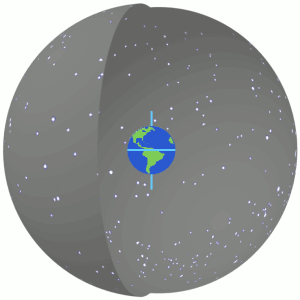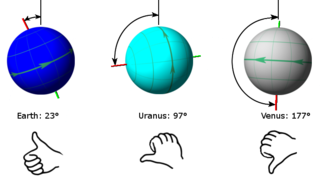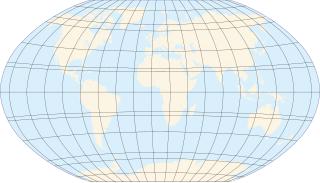
In astronomy, declination is one of the two angles that locate a point on the celestial sphere in the equatorial coordinate system, the other being hour angle. The declination angle is measured north (positive) or south (negative) of the celestial equator, along the hour circle passing through the point in question.

The ecliptic or ecliptic plane is the orbital plane of Earth around the Sun. From the perspective of an observer on Earth, the Sun's movement around the celestial sphere over the course of a year traces out a path along the ecliptic against the background of stars. The ecliptic is an important reference plane and is the basis of the ecliptic coordinate system.

Geodesy or geodetics is the science of measuring and representing the geometry, gravity, and spatial orientation of the Earth in temporally varying 3D. It is called planetary geodesy when studying other astronomical bodies, such as planets or circumplanetary systems. Geodesy is an earth science and many consider the study of Earth's shape and gravity to be central to that science. It is also a discipline of applied mathematics.

In geography, latitude is a coordinate that specifies the north–south position of a point on the surface of the Earth or another celestial body. Latitude is given as an angle that ranges from −90° at the south pole to 90° at the north pole, with 0° at the Equator. Lines of constant latitude, or parallels, run east–west as circles parallel to the equator. Latitude and longitude are used together as a coordinate pair to specify a location on the surface of the Earth.
Universal Time is a time standard based on Earth's rotation. While originally it was mean solar time at 0° longitude, precise measurements of the Sun are difficult. Therefore, UT1 is computed from a measure of the Earth's angle with respect to the International Celestial Reference Frame (ICRF), called the Earth Rotation Angle. UT1 is the same everywhere on Earth. UT1 is required to follow the relationship

The equatorial coordinate system is a celestial coordinate system widely used to specify the positions of celestial objects. It may be implemented in spherical or rectangular coordinates, both defined by an origin at the centre of Earth, a fundamental plane consisting of the projection of Earth's equator onto the celestial sphere, a primary direction towards the March equinox, and a right-handed convention.

In astronomy, the ecliptic coordinate system is a celestial coordinate system commonly used for representing the apparent positions, orbits, and pole orientations of Solar System objects. Because most planets and many small Solar System bodies have orbits with only slight inclinations to the ecliptic, using it as the fundamental plane is convenient. The system's origin can be the center of either the Sun or Earth, its primary direction is towards the March equinox, and it has a right-hand convention. It may be implemented in spherical or rectangular coordinates.

Sidereal time is a system of timekeeping used especially by astronomers. Using sidereal time and the celestial coordinate system, it is easy to locate the positions of celestial objects in the night sky. Sidereal time is a "time scale that is based on Earth's rate of rotation measured relative to the fixed stars".
A sidereal year, also called a sidereal orbital period, is the time that Earth or another planetary body takes to orbit the Sun once with respect to the fixed stars.

In astronomy, axial tilt, also known as obliquity, is the angle between an object's rotational axis and its orbital axis, which is the line perpendicular to its orbital plane; equivalently, it is the angle between its equatorial plane and orbital plane. It differs from orbital inclination.

A circle of latitude or line of latitude on Earth is an abstract east–west small circle connecting all locations around Earth at a given latitude coordinate line.
The Chandler wobble or Chandler variation of latitude is a small deviation in the Earth's axis of rotation relative to the solid earth, which was discovered by and named after American astronomer Seth Carlo Chandler in 1891. It amounts to change of about 9 metres (30 ft) in the point at which the axis intersects the Earth's surface and has a period of 433 days. This wobble, which is an astronomical nutation, combines with another wobble with a period of six years, so that the total polar motion varies with a period of about 7 years.

Mizusawa was a city located in Iwate Prefecture, Japan. It is currently part of the city of Ōshū. Mizusawa is home to one of the six International Latitude Observatories. The observatories were close to the parallel of 39 degrees 8 minutes north latitude. They worked together to study the Earth's "wobble" using stars selected by Dr. Kimura, the astronomer in charge of the Mizusawa station. Twelve groups of stars that had six pairs of stars each were chosen. Two groups of stars were observed at each station following a schedule of dates, time, and duration prepared by Kimura.

Seth Carlo Chandler, Jr. was an American astronomer, geodesist, and actuary.

The Gaithersburg Latitude Observatory is a historic astronomical observatory on DeSellum Avenue in Gaithersburg, Maryland. It was established in 1899 as part of a system of six International Latitude Observatories to precisely measure the wobble of the Earth's rotating axis. The observatory building and adjacent monuments were designated a National Historic Landmark in 1989 as a testament to international scientific cooperation. The observatory was taken out of service in 1982 after automation eliminated the need for human observations; the property is now owned by the city.

The National Astronomical Observatory of Japan (NAOJ) is an astronomical research organisation comprising several facilities in Japan, as well as an observatory in Hawaii and Chile. It was established in 1988 as an amalgamation of three existing research organizations - the Tokyo Astronomical Observatory of the University of Tokyo, International Latitude Observatory of Mizusawa, and a part of Research Institute of Atmospherics of Nagoya University.

Polar motion of the Earth is the motion of the Earth's rotational axis relative to its crust. This is measured with respect to a reference frame in which the solid Earth is fixed. This variation is a few meters on the surface of the Earth.
The International Time Bureau, seated at the Paris Observatory, was the international bureau responsible for combining different measurements of Universal Time. The bureau also played an important role in the research of time keeping and related fields: Earth rotation, reference frames, and atomic time. In 1987 the responsibilities of the bureau were taken over by the International Bureau of Weights and Measures (BIPM) and the International Earth Rotation and Reference Systems Service (IERS).
Tempo is a computer program to analyze radio observations of pulsars. Once enough observations are available, Tempo can deduce the pulsar rotation rate and phase, astrometric position and rates of change, and parameters of binary systems, by fitting models to pulse times of arrival measured at one or more terrestrial observatories. This is a non-trivial procedure because much larger effects must be removed before the detailed fit can be performed. These include:
August Ludwig Busch was a German astronomer who served as an assistant to Friedrich Bessel and from 1846, headed the Königsberg observatory.













